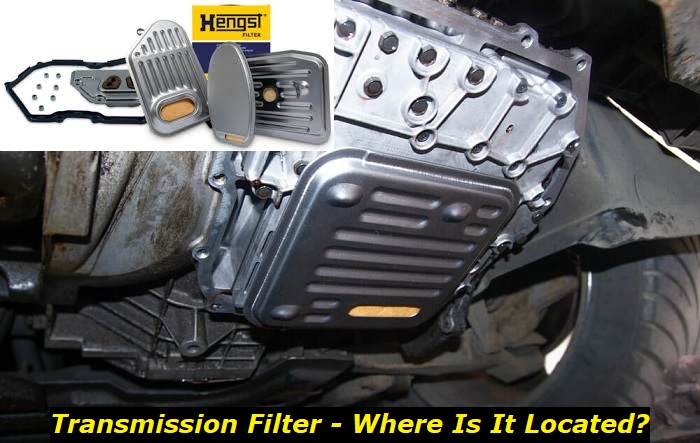The transmission is one of the vital systems of your vehicle. It transfers the power that moves your car from the engine to the wheels. If your transmission fails, it can cause a lot of trouble. A faulty transmission affects your vehicle's fuel economy and can sometimes render it immobile if you do not handle the problem immediately.
Fluid change in transmissions highlights
- Level of importance:High
- Time interval:Once every 60,000 miles or 10 years (if other not stated by the manufacturer)
- Needed expertise:High
- Needed tools:Basic set of car maintenance tools, plus car lift
- Time taken:2-4 hours
- Possible issues:Fatal failure of your transmission, jerking, harsh work, vibrations, limp mode, no shifting.

Transmission Filter location
The transmission filter is a key component of your transmission system. It sieves metal shavings and keeps them from damaging the transmission gears. It also keeps the transmission fluid from contamination by dust and debris.
This filter sits between the transmission pan and the tube that controls the fluid pressure. The filter features a metal plate with mesh inserts that filter the fluid to keep contaminants away. The system also has a rubber gasket that seals the filter to the transmission pan. There is also a pickup tube that links the filter to the oil pump and a seal found between the transmission case and the pickup tube.
What Is the Expected Lifespan of a Transmission Filter?
As mentioned earlier, a transmission filter is key to your vehicle's performance. Think of it as standing in the front line of defense, keeping contaminants out of the transmission fluid, hence maintaining the optimal performance of your transmission system. To keep this going well, you have to note the life expectancy of a transmission filter, as your vehicle manufacturer recommends.
Generally, most automakers recommend you use one transmission filter for not more than two years or every 30,000 miles. Whichever comes first, do not keep using the same transmission filter even if all signs show it is in good condition.
Important to note is that you should replace the transmission fluid and the pan gasket when changing the transmission filter.
What Are the Symptoms of a Faulty Transmission Filter?
These are the signs that your transmission filter needs a replacement.
1) Leaking
Your transmission fluid could leak for one of two reasons.
The first reason your transmission fluid could leak is when there is a clogged transmission filter. A clogged filter prevents the free flow of the fluid. As a result, it could show up outside the car as the blockage forces the fluid to flow through the vent tube. If you notice that you leave a trail behind when you power up your vehicle, you could have a clogged transmission filter. You should take the car to a mechanic for diagnosis.
Secondly, the transmission system comprises various seals that could suffer damage due to wear and tear. A broken seal or loose bearing could also cause the transmission fluid to leak. When any of these possibilities occur, you will notice that your car leaves a puddle underneath it wherever you park. If you do not address this issue immediately, the leakage could grow and eventually harm your transmission system.
2) Difficulty Shifting Gears
If you notice that shifting gears is becoming more and more difficult, your transmission filter may be clogged. When you have a clogged filter, the transmission gears become deprived of lubrication. Lubricated gears are smooth to shift.
When they lack lubrication, the transmission gears grind due to excess friction. This makes it difficult to shift gears and increases the rate of wear and tear. To fix this issue, change the transmission filter and replace the fluid.
If you own a manual transmission vehicle, you may notice that gears grind instead of shifting. You could hear the gears change. Although this could also mean you have a worn transmission plate, your transmission filter could be clogged or worn.
3) Burning Odor
A bad transmission filter prevents the free flow of the fluid and could also allow dirt and debris to contaminate the fluid. Too dirty transmission fluid can overheat and produce a burning smell and sometimes smoke. You can easily identify this smell from the cabin of your vehicle. A mechanic can also notice the smell when diagnosing your car.
A burning odor is the worst sign of a bad transmission filter. It shows that you ignored your transmission filter service schedule. It could also be because you ignored the first signs of a faulty transmission filter and continued driving without remedying the problem.
4) Strange Noises
There is nothing a driver fears the most than having a car producing strange noises they cannot explain. If your filter goes bad, the transmission gears will lack lubrication. The transmission's internal components will grind against each other due to increased friction. Additionally, if the transmission filter is bad and allows dirt and debris into the fluid, the internal components will grind as they rigidly move against each other.
When these happen, you will notice strange noises as the components grind due to resistance. Of course, a faulty filter is not the only cause of these noises. Your car can make strange noises if you have a broken or loose exhaust hanger, a faulty transmission, torn brake pads, or a faulty catalytic converter.
When diagnosing your vehicle because of these strange noises, rule out these issues before narrowing it down to a bad transmission filter.
However, if your problem is truly a bad transmission filter, you will hear these noises clearly when you shift to reverse or drive. When the filter has no questions, gears shift smoothly and do not make any audible noises. Therefore, whenever you hear strange noises when shifting, your transmission filter needs attention.
Another sure sign of a bad transmission filter related to strange noises is when you hear the noises, yet your car is in neutral gear. Mostly, cars are silent when the shifter is in neutral. The noises feel like your car is shifting gears and not engaging them. Red light is when the noises are recurring. This means your transmission has a severe problem that requires immediate attention.
If you drive an automatic transmission vehicle, a bad filter will make whiny, whirly, or high-pitched noises. Additionally, you will experience a jerky and awkward drivability problem.
When Should I Change My Transmission Filter?
Over time, the transmission filter wears and begins to let tiny bits of metal shavings through. Although every manufacturer recommends a specific time or mileage to change the transmission filter, most vehicles fall within the two years or 30,000-mile window.
The schedule mostly depends on the vehicle's make and model, but the safe window is between 30,000 and 50,000 miles. Some vehicles can use one transmission filter for nearly 100,000 miles without developing any problems.
Changing the transmission filter can be a demanding task. Very few transmission units have a drain plug, so you may have to take a few components apart to access the transmission filter.
If you plan to do the job in-house, these are the few things you must have.
- A transmission filter
- A transmission pan gasket
- Transmission fluid. It is important to buy the exact fluid recommended by your manufacturer.
- A jack and jack stands
- A set of socket wrench
- A gasket seal adhesive
- A flathead screwdriver
- Other accessories include a shop towel, a scrapper, and a plastic container.
What Is The Transmission Filter Replacement Cost?
It is important to fix a faulty transmission filter and replace the fluid as soon as it is time. Driving with a faulty transmission filter could cause severe issues to your vehicle. Take your vehicle to the dealership or a professional mechanic to replace the filter and add new transmission fluid.
The cost of the new parts ranges between $50 and $100. If you pay a mechanic, the price could rise to between $300 and $400, depending on the make and model of your vehicle. The final cost of the filter replacement will also depend on the quality of the parts and fluid you choose to use.
Labor charges decrease or increase depending on how difficult it is to access the transmission filter of your vehicle.
Is It Safe to Drive with a Faulty Transmission Filter?
Generally, driving with a past service schedule or a faulty part is not recommended. Although the vehicle will move, it will cost you more in repairs in the future than fixing the transmission filter now. If your vehicle is past service time or has shown a sign of bad transmission fluid, take it to the mechanic for service and repair.
If you notice any of the signs mentioned here, towing your car to the repair shop may be safer than driving. A faulty transmission filter may sound minor, but leaving it unattended can cause severe drivability issues. It can damage the transmission system and even make it difficult to drive your vehicle.
Conclusion
Do you know the service schedule for your vehicle's transmission filter? Consult your owner's manual or the official website of the manufacturer. Have you noticed any signs of a faulty transmission filter? Take your vehicle to the dealership or mechanic, or attend to the problem immediately.
About the authors
The CarAraC research team is composed of seasoned auto mechanics and automotive industry professionals, including individuals with advanced degrees and certifications in their field. Our team members boast prestigious credentials, reflecting their extensive knowledge and skills. These qualifications include: IMI: Institute of the Motor Industry, ASE-Certified Master Automobile Technicians; Coventry University, Graduate of MA in Automotive Journalism; Politecnico di Torino, Italy, MS Automotive Engineering; Ss. Cyril and Methodius University in Skopje, Mechanical University in Skopje; TOC Automotive College; DHA Suffa University, Department of Mechanical Engineering






Add comment